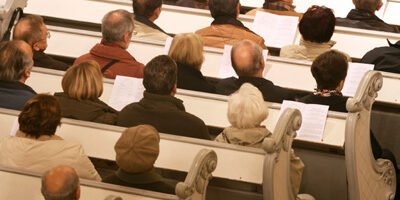At their deepest level, human beings are social creatures, in the image, Christians would say, of the Trinity itself. But the individualistic bent of modern American society has led writers to focus more on the spiritual needs and growth of individuals than on the needs and growth of the religious groups to which these individuals belong. As a result, our vocabulary for addressing the needs of church congregations, intentional faith communities and other religious groups – which are not necessarily the same as addressing the needs of the individual members of these communities – is sadly impoverished. As one parish consultant remarked, he had to “baptize” concepts from business team-building exercises to use in helping local congregations, sometimes with less than optimal results.
The aim of this book is to help the members of local parishes, small faith groups, religious order, lay ecclesial movements, and other manifestations of community in Catholic (and other) churches to develop the tools they will need to reflect upon the health or weakness of their vital communal ties, to weigh and evaluate the practices that have strengthened communities in other times and places, and – most importantly – to discern whether and when to put aside individualistic preferences or bureaucratic efficiency in order to attend to communal needs.
Building Strong Church Communities first applies the sociological literature on community – which has grown exponentially since Robert Putnam first published “Bowling Alone” – to Catholic parishes, religious orders, new ecclesial movements, and even internet groups. Previous research on these communal expressions of Catholicism, drawn from numerous studies by the Center for Applied Research in the Apostolate at Georgetown University, is described, especially the findings which relate to the importance and functioning of community in these settings. Chapter 2 notes that a sense of belonging and being part of a parish community are among the most important aspects which attract parishioners to a particular congregation. Chapter 3 addresses the common assumption that parish communities were stronger in the past: “The farther back in history we look, the more skeptical we may become about whether an idealized golden age of parish community has ever had any basis in fact.” (p. 39) Chapter 4 considers both the benefits and the liabilities of building a strong community spirit within a parish. Chapters 5 and 6 consider forms of community outside of the local parish – religious orders and the new ecclesial movements – together with the opportunities and pitfalls such groups present for the larger Church. Chapter 7 considers the impact of the internet on religion in general, and on Church communities in particular.
Based on this research, Chapters 8 and 9 define four key tasks which all communities, religious and secular, must continue to perform successfully if they are to survive: building and maintaining a clear identity that unites the members, establishing boundaries that define who is/is not a member in a way that helps the group, facing and redeeming conflicts, and attracting/incorporating the next generation. These tasks require an ongoing evaluation of the community’s health and functioning: the strength and attractiveness of its identity (or whether it needs to change or develop in a new way); the visible and invisible boundaries against non-members (and whether the community is subconsciously erecting boundaries against the very persons it claims to welcome); which subgroup or faction exercises the power in the community (and whether this is resented by those who don’t); and how successfully the community connects with teens and young adults. Practical suggestions are given of ways other church communities have addressed each of these issues.
A fundamental dilemma which all church communities must face is that there is no ideal midpoint balancing the needs of the community and the needs of the individuals such that both are completely met. Attending to the health and functioning of a parish congregation, a religious order, or other church community as a whole will necessarily mean that its members must give up something that would have been good for them as individuals – leisure, economic benefits, even work or living preferences – for the good of the group. Attending to the health and functioning of individual members will necessarily mean, at times, short-changing the needs of the community as a whole. Building Strong Church Communities is an attempt to help the members of these communities develop the knowledge and skills they need to discern which to do when.

